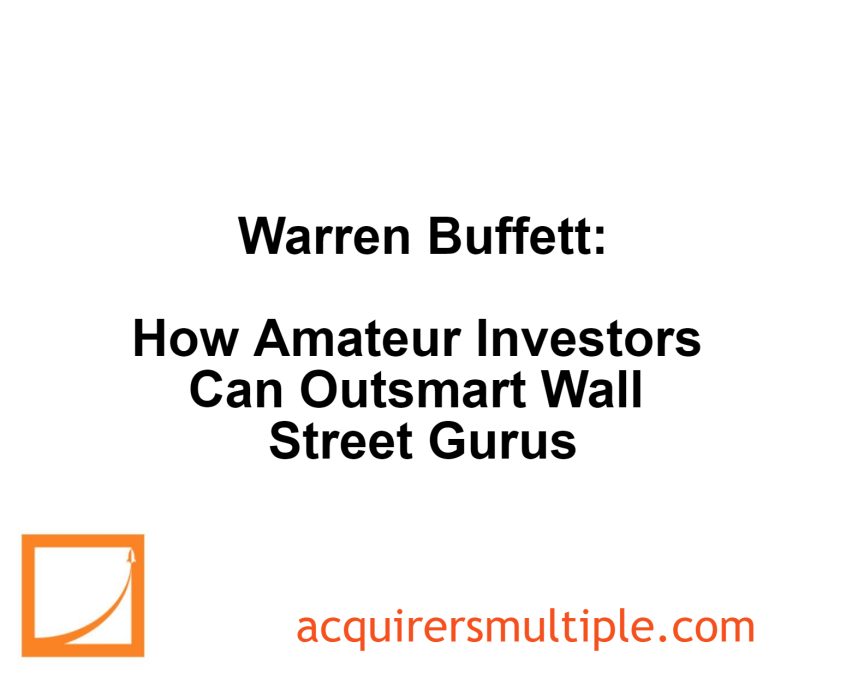In his 2013 Berkshire Hathaway Annual Letter, Warren Buffett outlined an investing strategy that could be used by non-professional investors to achieve success in the stock market.
His key points for non-professional investors were:
- You don’t need special skills to invest. American businesses generally do well over time
- Aim to own “a cross-section of businesses” through low-cost index funds like S&P 500
- Invest consistently over time, avoid getting caught up in market highs or lows
Here’s an excerpt from the letter:
When Charlie and I buy stocks — which we think of as small portions of businesses — our analysis is very similar to that which we use in buying entire businesses.
We first have to decide whether we can sensibly estimate an earnings range for five years out, or more. If the answer is yes, we will buy the stock (or business) if it sells at a reasonable price in relation to the bottom boundary of our estimate.
If, however, we lack the ability to estimate future earnings — which is usually the case — we simply move on to other prospects. In the 54 years we have worked together, we have never foregone an attractive purchase because of the macro or political environment, or the views of other people. In fact, these subjects never come up when we make decisions.
It’s vital, however, that we recognize the perimeter of our “circle of competence” and stay well inside of it. Even then, we will make some mistakes, both with stocks and businesses.
But they will not be the disasters that occur, for example, when a long-rising market induces purchases that are based on anticipated price behavior and a desire to be where the action is.
Most investors, of course, have not made the study of business prospects a priority in their lives. If wise, they will conclude that they do not know enough about specific businesses to predict their future earning power.
I have good news for these non-professionals: The typical investor doesn’t need this skill. In aggregate, American business has done wonderfully over time and will continue to do so (though, most assuredly, in unpredictable fits and starts).
In the 20th Century, the Dow Jones Industrials index advanced from 66 to 11,497, paying a rising stream of dividends to boot.
The 21st Century will witness further gains, almost certain to be substantial. The goal of the non-professional should not be to pick winners — neither he nor his “helpers” can do that — but should rather be to own a cross-section of businesses that in aggregate are bound to do well.
A low-cost S&P 500 index fund will achieve this goal.
That’s the “what” of investing for the non-professional. The “when” is also important. The main danger is that the timid or beginning investor will enter the market at a time of extreme exuberance and then become disillusioned when paper losses occur.
(Remember the late Barton Biggs’ observation: “A bull market is like sex. It feels best just before it ends.”) The antidote to that kind of mistiming is for an investor to accumulate shares over a long period and never to sell when the news is bad and stocks are well off their highs.
Following those rules, the “know-nothing” investor who both diversifies and keeps his costs minimal is virtually certain to get satisfactory results.
Indeed, the unsophisticated investor who is realistic about his shortcomings is likely to obtain better long-term results than the knowledgeable professional who is blind to even a single weakness.
If “investors” frenetically bought and sold farmland to each other, neither the yields nor prices of their crops would be increased.
The only consequence of such behavior would be decreases in the overall earnings realized by the farm-owning population because of the substantial costs it would incur as it sought advice and switched properties.
Nevertheless, both individuals and institutions will constantly be urged to be active by those who profit from giving advice or effecting transactions.
The resulting frictional costs can be huge and, for investors in aggregate, devoid of benefit. So ignore the chatter, keep your costs minimal, and invest in stocks as you would in a farm.
My money, I should add, is where my mouth is: What I advise here is essentially identical to certain instructions I’ve laid out in my will.
One bequest provides that cash will be delivered to a trustee for my wife’s benefit. (I have to use cash for individual bequests, because all of my Berkshire shares will be fully distributed to certain philanthropic organizations over the ten years following the closing of my estate.)
My advice to the trustee could not be more simple: Put 10% of the cash in short-term government bonds and 90% in a very low-cost S&P 500 index fund. (I suggest Vanguard’s.)
I believe the trust’s long-term results from this policy will be superior to those attained by most investors — whether pension funds, institutions or individuals — who employ high-fee managers.
You can read the entire letter here:
For all the latest news and podcasts, join our free newsletter here.
Don’t forget to check out our FREE Large Cap 1000 – Stock Screener, here at The Acquirer’s Multiple:



